According to the American Poultry Association, there are 53 different standard-sized breeds of chickens, plus lots of smaller breeds called “bantams.”
Like dogs and cats, chickens of different varieties can also breed and create interesting, unofficial hybrids!
There are also plenty of birds out there who just look like chickens.
Pheasants, grouse, firebacks, and quails all have the potential to look like chickens! These chicken-like birds live all over the world, just like domesticated chickens.
While chickens are raised to provide eggs and meat, these birds are mostly game birds.
Let’s take a look at the plentiful birds that may resemble the backyard chickens in your urban neighborhood or the countryside on sprawling farms!
Pheasants That Look Like Chickens
Pheasants are relatively large birds found on the ground rather than among trees. Even though they can fly if they have to, they are much more likely to start running.
When they do fly, their typical airspeed is 38 to 48mph. They can fly as fast as 60 mph when something is pursuing them!
They are also known for jumping or bursting upwards if they get scared in a move called a “flush.”
Males weigh about 2.5 lb, and females weigh 2 lb. They have short life spans because of their many predators, including foxes, raccoons, skunks, outdoor cats, hawks, owls, and humans.
Blood Pheasant
Blood pheasants are also called blood partridges because they are shaped similarly to a partridge. The “blood” label comes from the bright red tail of the males of this species.
They can be found in Central and Southern China, Nepal, and Bhutan. These types of birds like living in coniferous forests and oak woodlands.
Male blood pheasants are silvery-grey and have light-colored streaks all over their bodies. A male’s face is tinged with red, as it has a tail and breast.
The female has an orange face and a pale body. They both have small head sizes and are from central Mexico. They also have size differences in terms of their distinctive crest.
Blood pheasants have orange feet and are orange around their eyes. These colored birds are a type of pheasant with a distinctive forward-facing crest.
Blue-Eared Pheasant

Blue-Eared Pheasants are striking in appearance! They are only found in China. Because hunting blue-eared pheasants are common, they avoid living near people, towns, or villages.
Like other pheasants, they stay on the ground. They can be found in alpine forests and meadows. For most of the year, they thrive in small community groups. During the breeding season, they pair up with a partner.
They don’t really have blue ears. Instead, these somewhat comically large white feathers extend past their ears and point toward the sky. This is in contrast to their dark silver bodies and red faces.
They also have a complicated tail–their black-ish silver and white tail feathers are topped with a few distinct, frilly feathers.
Copper Pheasant
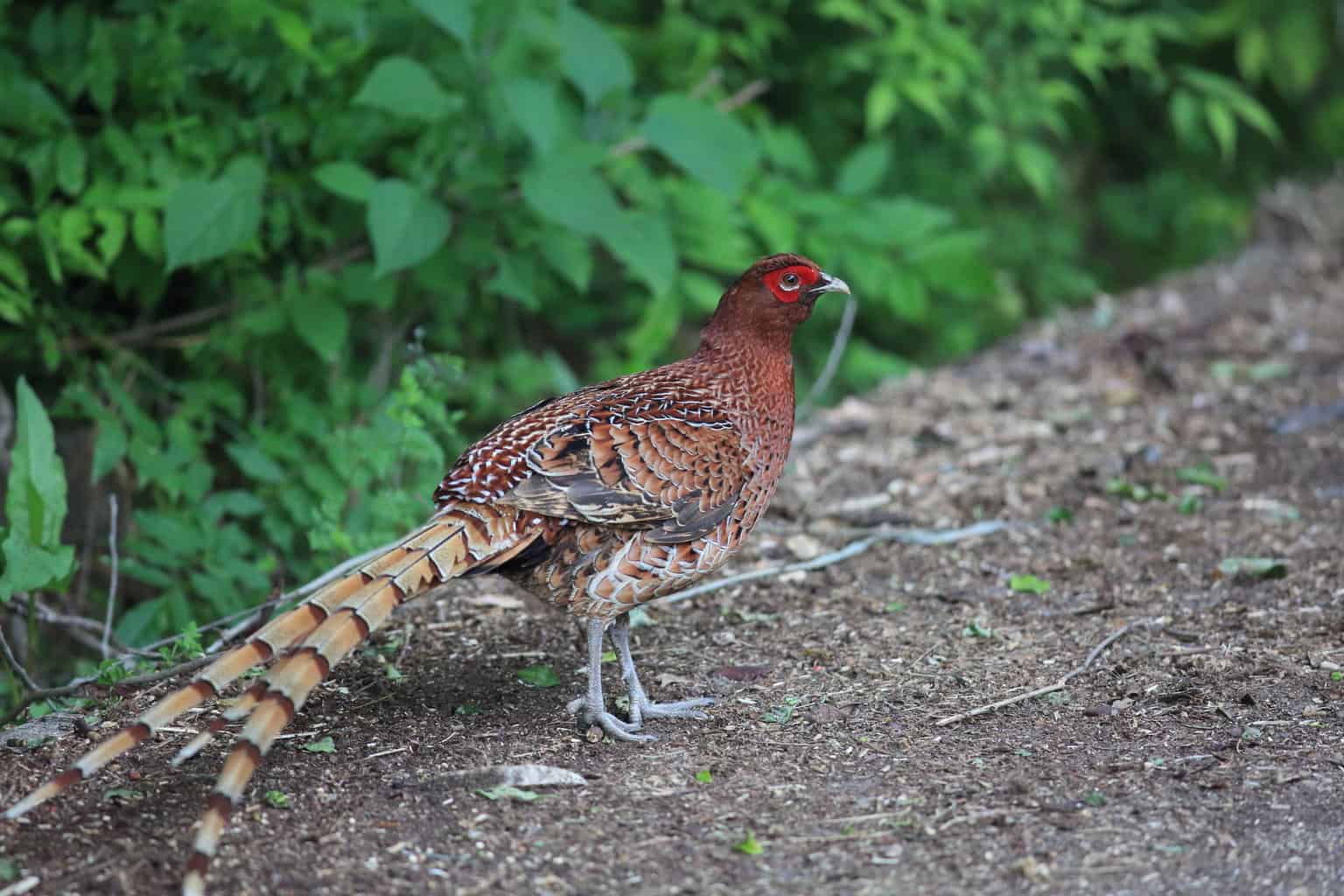
Copper Pheasants are called Soemmerring’s Pheasants, named after a German scientist. They can be found in the mountainous forests and hills of Japan.
Their feathers are dark copper color, with yellow bills and red skin on their faces. Males have spurs on their legs, similar to roosters. Females lack those spurs.
They are categorized as “near-threatened,” which means they are not currently vulnerable or on their way toward extinction, but their population would need to improve before they could be listed as “not of concern.”
Crested Fireback
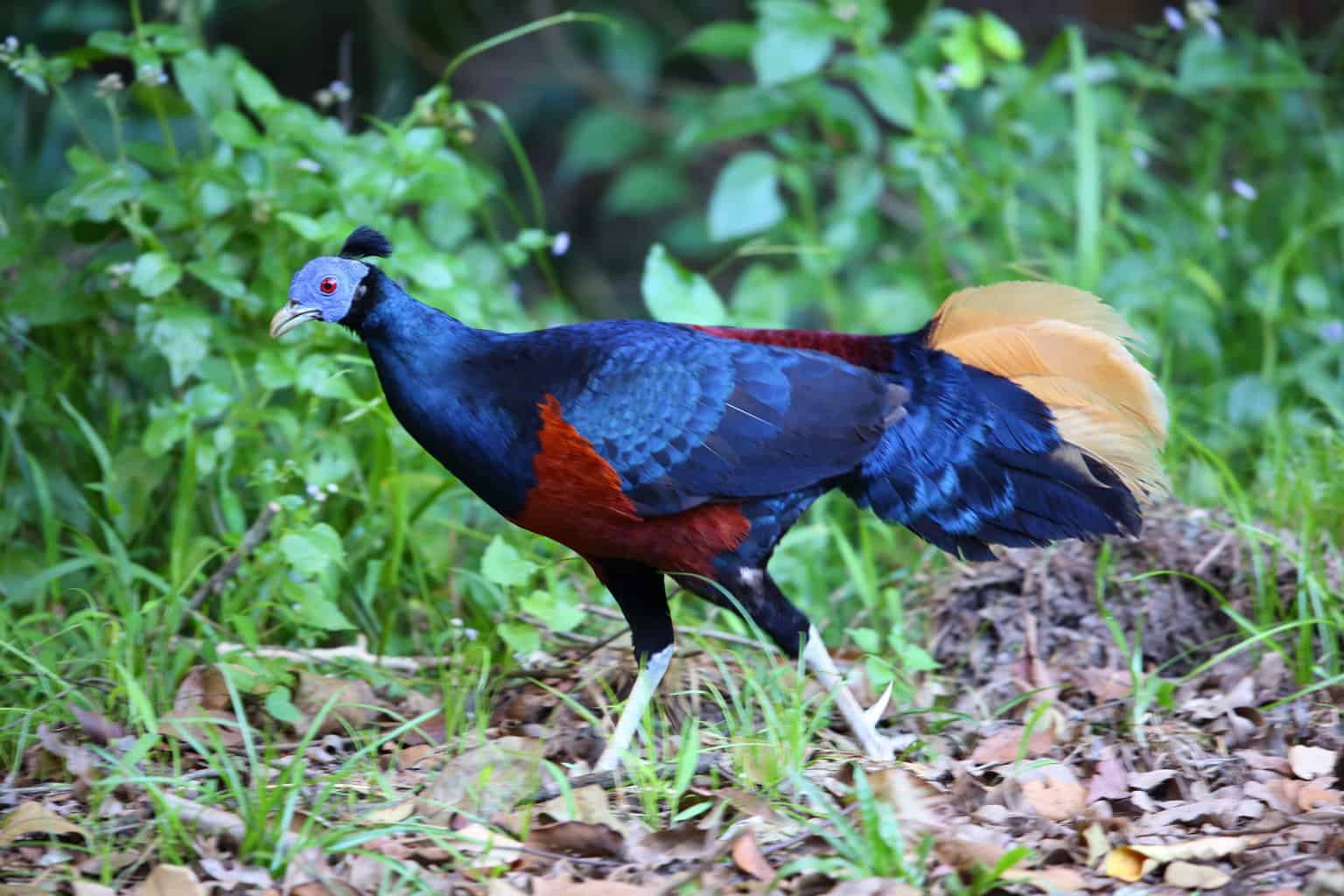
Very few birds have such a dramatic face! Crested firebacks are a kind of forest pheasant with bright blue facial skin. Males also have a little crest of a few feathers on the top of their heads.
Each female has the same bright blue facial skin as the males, but her head has more feathers, which means we see less skin.
Depending on where they reside, other aspects of their appearance can vary significantly. For example, Crested Firebacks in Broneo have a yellow tail and a vibrant orange belly. In Sumatra, they have red backs and white tails.
They live in the lowland forest of Indonesia, Malaysia, Brunei, and Myanmar.
Crestless Fireback
Crestless Firebacks are small and stocky. They are dark black or slate blue but have crimson-red facial skin reminiscent of some of the pheasants in this section.
They have a very chicken-ish shape and move on the ground like chickens.
They live in the canopied rainforests of Brunei, Malaysia, Indonesia, and Singapore. Unfortunately, they are critically endangered due to habitat destruction and have not been extensively studied.
Edward’s Pheasant
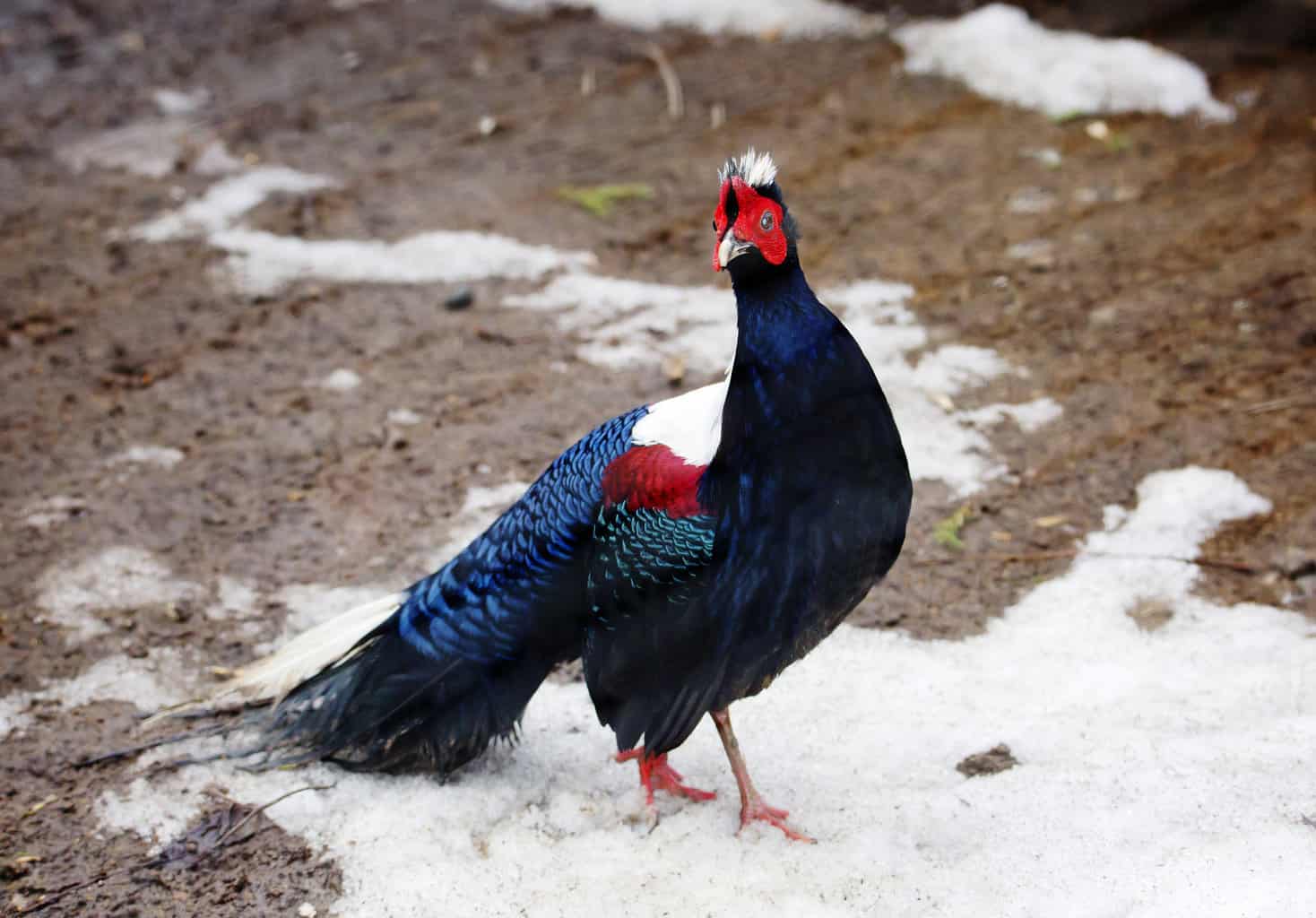
Many species of pheasants originated in Asia, and Edward’s Pheasant is no exception. These beautiful black birds have previously been found in Vietnam but are critically endangered. Sadly, there have been no sightings of wild Edward’s Pheasants.
Males are dark blue with an iridescent hue. Females are brown. Males have a small white crest atop their heads, whereas females have no crest.
Green Pheasant

Green Pheasants are ornately decorated. They are also called Japanese Green Pheasants and are native to Japan. They are also found in Hawaii, Western Europe, and a few places in the continental United States.
Green Pheasants are even the national bird of Japan!
Males are metallic green with some tinges of olive blue and grey. Their necks are violet and have a green-grey rump and a green and purple tail. Their legs are black.
Females have more subdued coloring, and they have more mottling. They are better at disguising themselves among the brush than males.
Hoogerwerf’s Pheasant
Andries Hoogerwerf was a Dutch ornithologist who was also an accomplished taxidermist. The Hoogerwerf’s Pheasant is named for him but is also called the Aceh Pheasant and the Sumatran Pheasant.
The Aceh province of Indonesia is home to interesting cresent. Males lack any sort of crest. Males and females both have red skin on their faces and short tales. Females have rufous brown coloration, and males are blueish-black.
Unfortunately, there are very few Hoogerwerf’s pheasants in the world today.
Koklass Pheasant

Koklass Pheasants are described as timid. They live in mid-range or high-altitude forests in China, Nepal, Northern India, and Pakistan.
Males are silver with a purplish-red breast stripe and white-patched neck. Their heads are dark green, almost black, and have a long crest that is sometimes described as looking like an alert or startled rabbit.
Females have more subtle neck patches, striped breasts, and a short crest.
These birds are partridge-shaped, but they also look like a number of bantam chicken breeds.
Mountain Peacock Pheasant
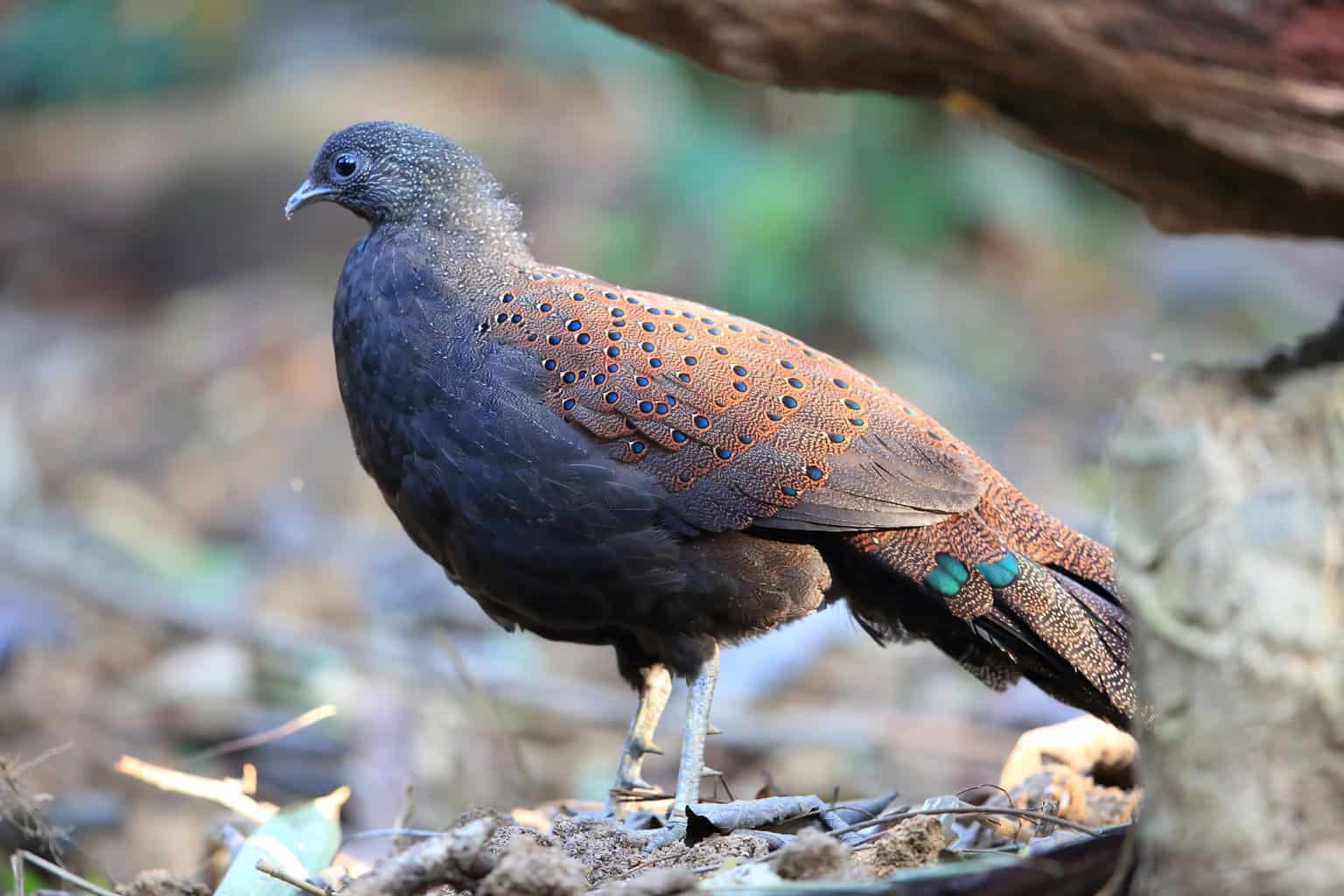
You may have noticed that pheasants are often found in mountainous regions. That’s true for the Mountain Peacock Pheasant as well!
Their name, “peacock pheasant,” makes sense when you see them. They have peacock-shaped tails that they can fan out! Males’ tails have emerald-green sparkles that they can display when they want to draw attention to themselves.
These are shy, timid pheasants who avoid being seen by humans. They live in Malaysia.
Ring-Necked Pheasant

Ring-Necked Pheasants were originally from Asia but became established in California by the 1800s. When you think of a stuffed pheasant sitting on a bookshelf in a fancy antique store, you’re probably thinking of the iconic Ring-Necked Pheasant.
These stunning little birds are vibrantly colored and shaped like chickens.
Their red faces contrast with their iridescent green necks, which are ringed in white. Males have long tails; instead of curving like a rooster’s tail, the tail of a male Ring-Necked Pheasant points backward at an upward angle.
Its coloration is copper with black bands from top to bottom. Females are more muted in color.
Siamese Fireback

What a fancy bird the Siamese Fireback is! I don’t think I’ve seen many birds this stunning.
The red patch on their rump (which gives them their name!) is difficult to see, but they make up for that with their iridescent blue and gorgeous, long, black tail feathers.
They have vibrant red facial skin and a frilly crest atop their heads. Females are brown instead of dark grey.
Males have a very loud whistle, which they use to get the attention of females in the area.
They can be found in Laos, Vietnam, Thailand, and Cambodia.
Swinhoe’s Pheasant

You will find the curious-looking Swinhoe’s Pheasant in the mountains of Thailand. Because of its red, white, and blue coloration, it is the unofficial bird of Thailand.
A male Swinhoe’s Pheasant will be dark blueish-grey, and a female will be dark brown. The red skin of a male’s face will stand out, even from a distance. He will also have red wattles and a white crest.
Females have similar bright red skin tones, but it’s a bit more subtle because less of the face’s skin is exposed.
They get their name from Robert Swinhoe, a British naturalist. He first described this bird to western ornithologists in 1862.
White-Eared Pheasant
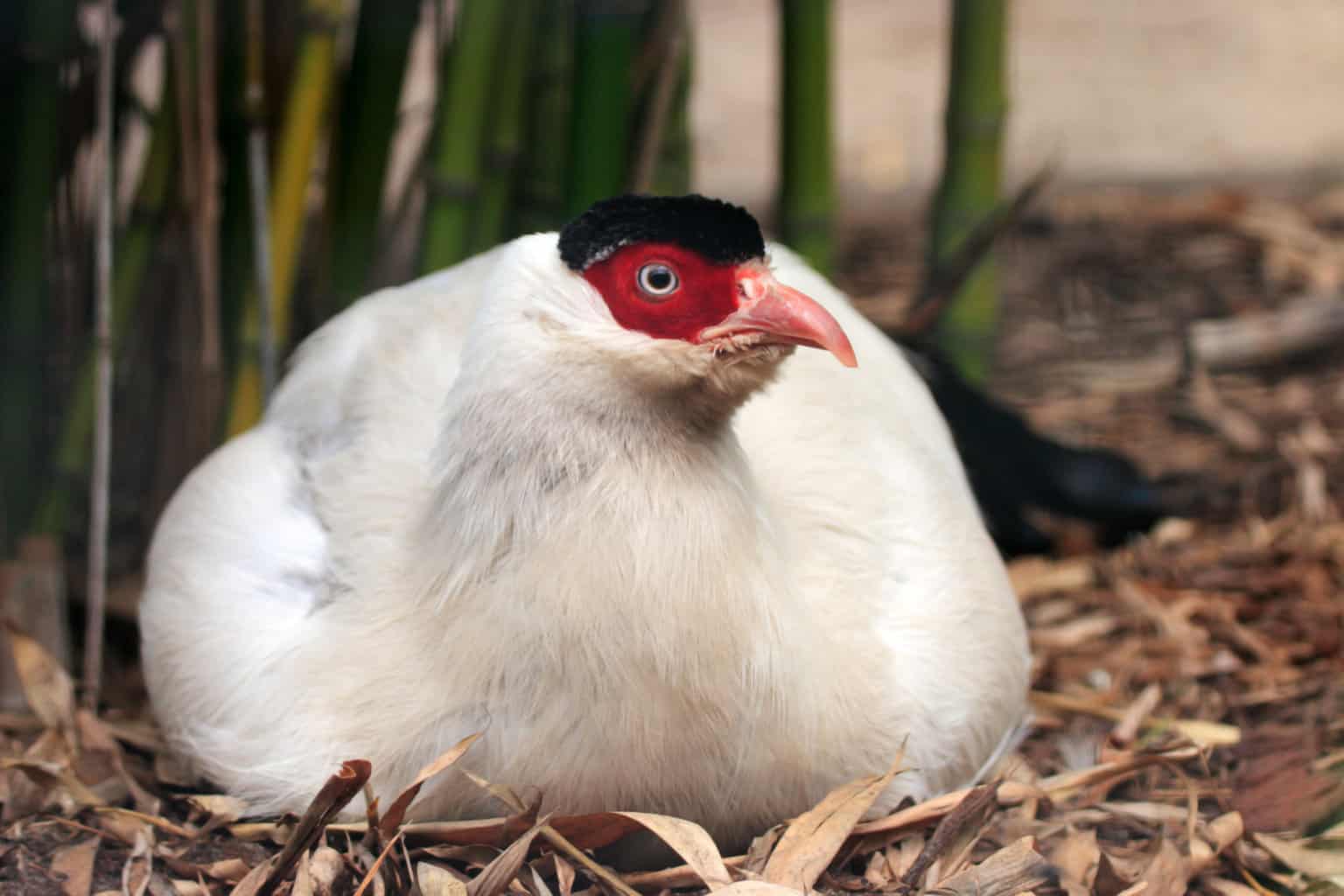
White-Eared Pheasants have mostly white bodies with red faces and black tail feathers. They look a bit like Light Brahama chickens without the mottling.
Like the Blue-Eared Pheasant, the White-Eared Pheasant gets its name from the white ear tufts. It does not actually have white ears.
In the Himalayan mountains, where it is from, the White-eared Pheasant is called shagga, a word that translates to “Snow fowl.”
They inhabit areas above the snow line in large groups. They can be found in China and Tibet.
Grouse That Look Like Chickens
A grouse is a relative of the pheasant.
They are found in Europe, Asia, and North America. Like pheasants, they live and nest on the ground and avoid flying unless predators are pursuing them. Even then, they often choose to run instead of taking flight.
Grouse range from quite small (less than a pound) to very large (7.5lb).
The average weight of a standard chicken is about 5.5 lb, meaning grouse can fall on either side of chickens in size.
Black Grouse

A Black Grouse male is dark black compared to a female’s dark brown coloring with a barred pattern covering the body.
Males are prone to displaying their tails in a fan shape and fluffing up their feathers. They also have a bright red crest in adulthood. Their tale is sometimes described as “lyre-shaped.”
They are most populous in Northern Europe, especially Scandinavia, but they can be found across the same latitude throughout parts of Russia, Kazakhstan, Mongolia, and China. They are game birds that are popular with hunters and birders alike.
Rock Ptarmigan

Rock Ptarmigans are a type of grouse. The “p” is silent, so you pronounce this bird’s name “tarr-muh-gn.” They are mid-sized birds, similar to a crow.
In the winter, these birds are white, but in the summer, they go through a molting process that leaves them with dark brown bodies and tails.
They never lose the whiteness of their legs or wings. When breeding, males have a bright red comb above their eyes.
These are tenacious birds who nest as far north as possible. They are found in Northern Canada and Alaska. Because they live on the tundra, their white coloration camouflages them and keeps them safe in the snowy winter months.
Their mottled brown coloration provides the same protection during the less snowy summer and fall.
They have feathered feet–much like many chicken breeds–and dig burrows in the snow and rocks.
Ruffed Grouse
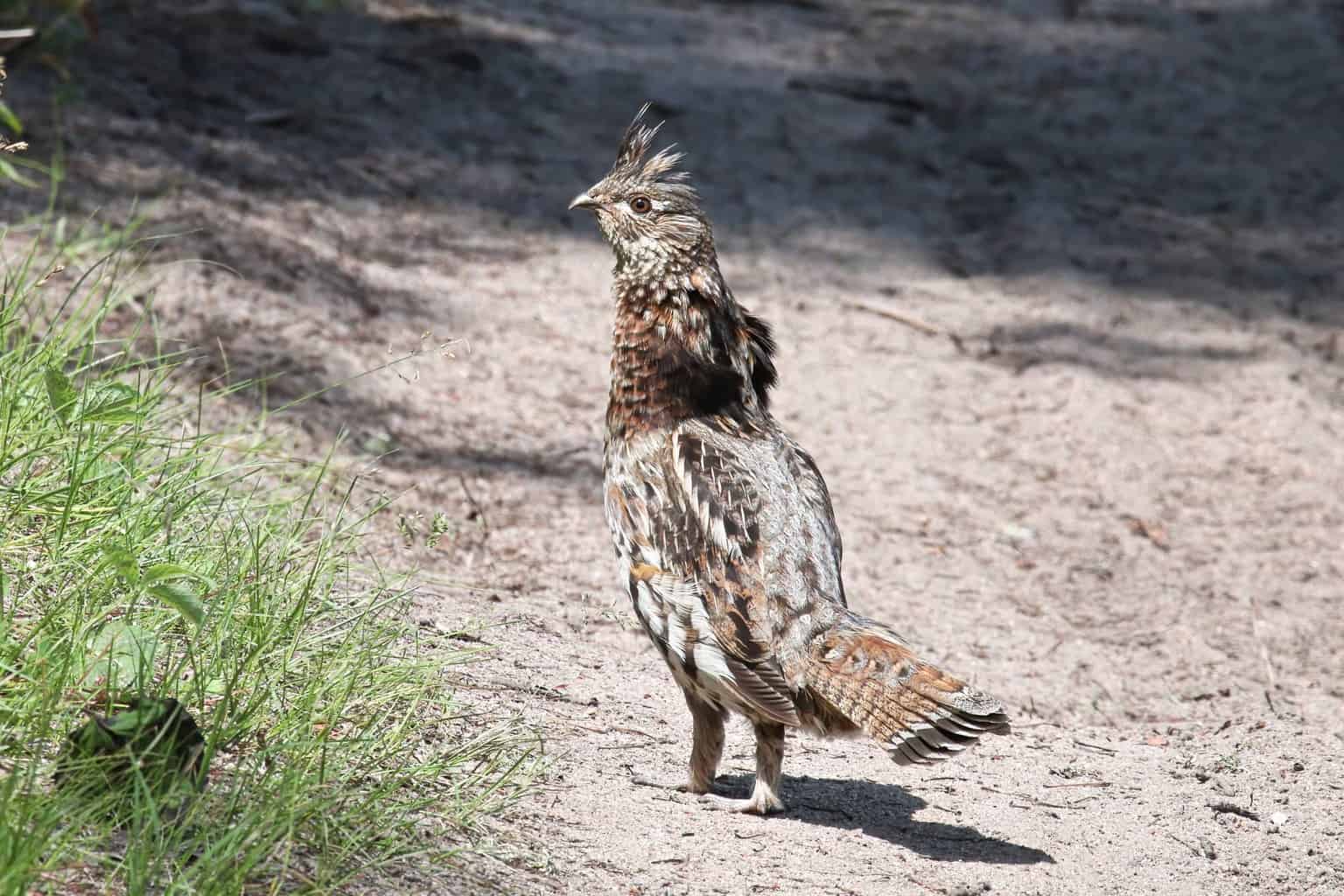
Ruffed Grouse are small with a complex feather pattern. They have spots, stripes, bars, and bands!
Certainly, their most noticeable feature, though, is the “ruff” of black neck feathers that males can puff up and show off when they are ready to display. These feathers form nearly a complete circle around the bird’s neck!
They are found year-round in the Northeast U.S., across Canada, and parts of the Northwest and northern Midwest.
Other Birds That Look Like Chickens
Grouse and pheasants aren’t the only birds that look like chickens. You can also see similarities between chickens and some quail, bobwhites, firebacks, and other birds.
Gambel’s Quail

Quail are small, similar to bantam chickens. A Gambel’s Quail has many colors: grey, chestnut brown, and creamy white. These colors and patterns make it easy for Gambel’s Quail to camouflage themselves in the underbrush!
The face of a male Gambel’s Quail is outlined in white. Females have a similar outline but with nowhere near as much contrast.
Both sexes have a “topknot” of feathers atop their heads. It’s larger in males than females. This little cluster of feathers is sometimes described as “comma-shape,” making them quite recognizable!
They live in the Southwestern region of the United States. Most are found in Arizona but may venture into Mexico, Texas, California, Utah, Nevadah, and Colorado.
Greater Prairie-Chicken
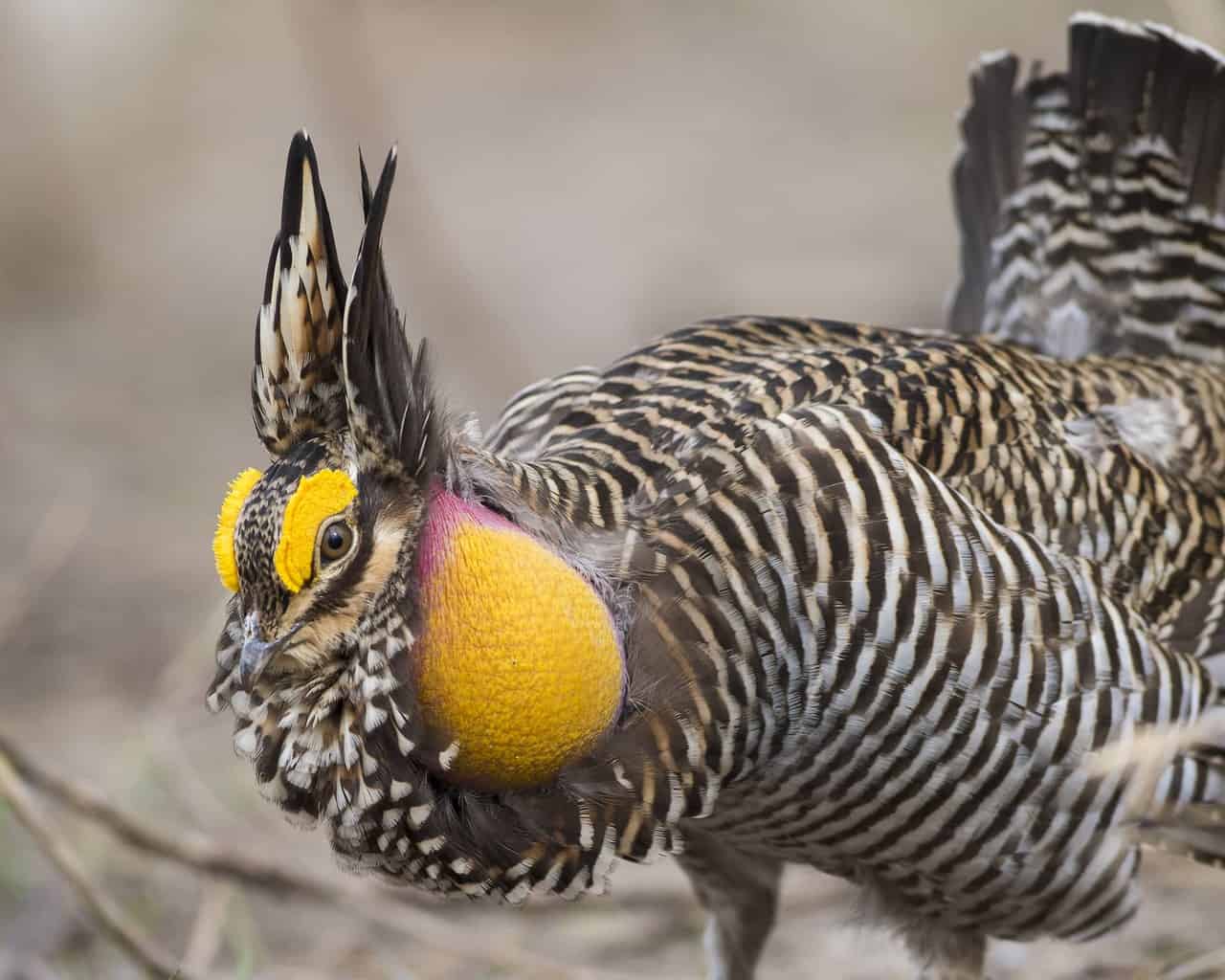
The Greater Prairie Chicken is not a chicken but shares the name anyway!
Both males and females have the same basic appearance, with one major difference. All adult Greater Prairie-Chickens have mottled brown and black feathers.
Their bellies are barred in brown and white. The major difference in appearance only shows up during mating season!
Males gather together to impress females, and when they do, they erect plumes on either side of their head that look like ears, and they inflate air sacs on their necks which look like bright orange golf balls or even tennis balls!
They live in the Great Plains of the U.S, but unfortunately, their habitat has shrunk considerably over time. They were once populous but now are listed as Vulnerable. Their numbers have been stable since the 1960s, though!
Northern Bobwhite Quail
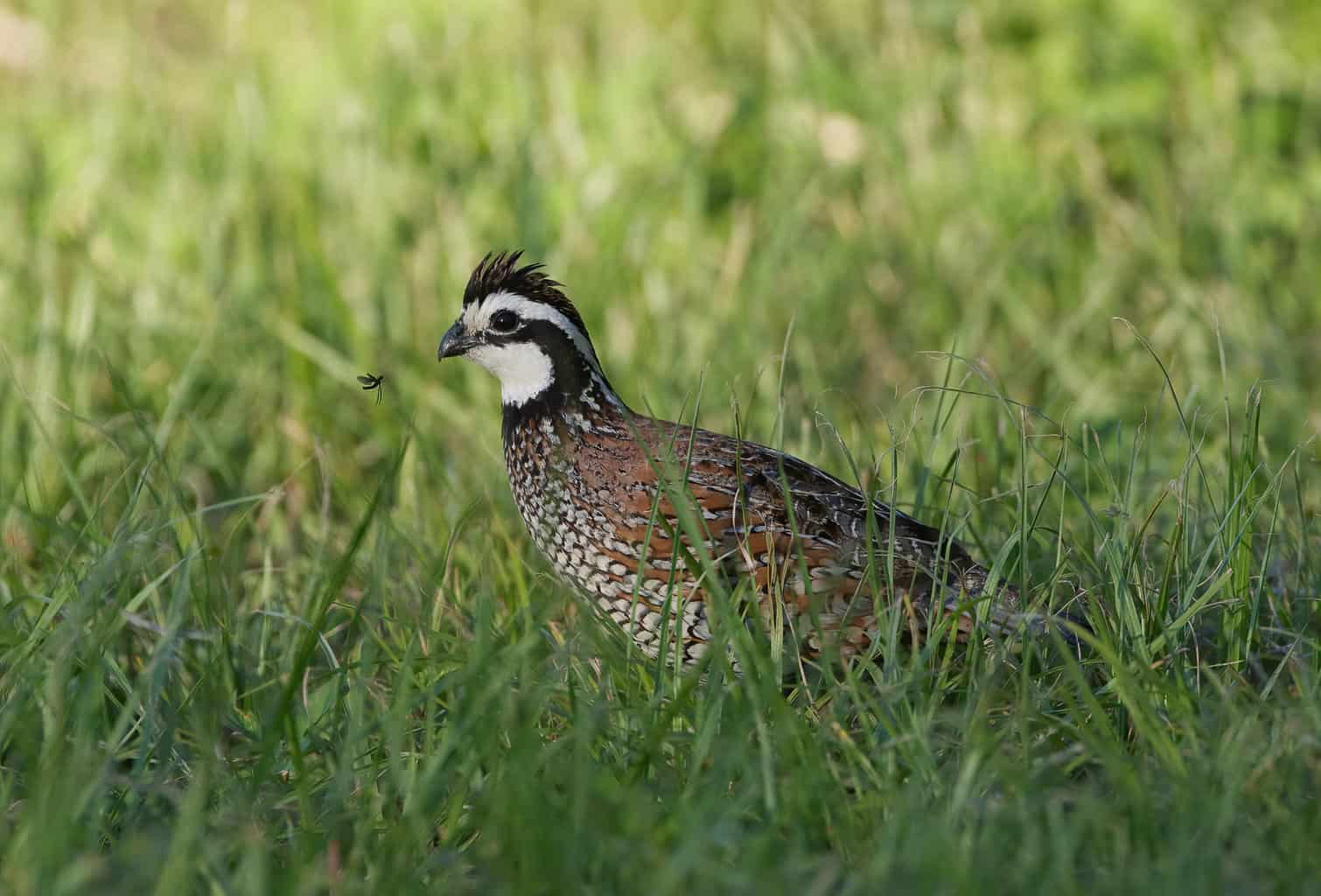
The bobwhite has one of the most easily recognizable calls. Kids learn to recognize the sound of the birds calling their own names, emphasizing the second syllabus: bob-WHITE, bob-WHITE!
The Northern Bobwhite Quail boasts a delicate pattern of brown, cream, rufous, black, and buff. Male Bobwhites have a head with lots of contrast between black and white. Females’ throats are buff-colored, matching their eyebrows.
They live in forests, fields, and grasslands, primarily in the Eastern United States, the Caribbean, and parts of Mexico.
Plain Chachalaca

A Plain Chachalaca has anything but a plain name! “Chachalaca” is fun; these birds are quite interesting to match their name!
They live along the East Coast of Mexico into Central America and can sometimes be spotted in the southern tip of Texas. They have a chicken-shaped head and neck.
Some people even refer to the Plain Chachalaca as a “tropical chicken” that leaves the ground to live in the treetops. Sandy brown and grey are not as colorful as many of the pheasants and grouse on this list.
They stand out because of their morning songs and calls, which are loud and enthusiastic.
Scaled Quail

Scaled Quail also goes by “Blue Quail” or “Cottontop.”
There is little difference between a male and female Scaled Quail. Both have light brown bellies with a dark brown scaling pattern. (Think about a snake’s scales or the pattern of a Wyandotte hen.)
They also both have a tall crest on their head. Scaled Quail live in the Southwest United States and into Mexico. They don’t migrate, so they can be seen year-round in their territory.
They are excellent at hiding, so you have to be keen-eyed to see one! They live in brushy areas that have cacti and sparse shrubs.
The Scaled Quail population fluctuates frequently and depends on severe or mild weather periods.
When water is scarce, or winter is too harsh, it can be difficult for these little birds to find food, and their population will plummet. They are very good at re-establishing themselves when conditions improve.
Wild Turkey
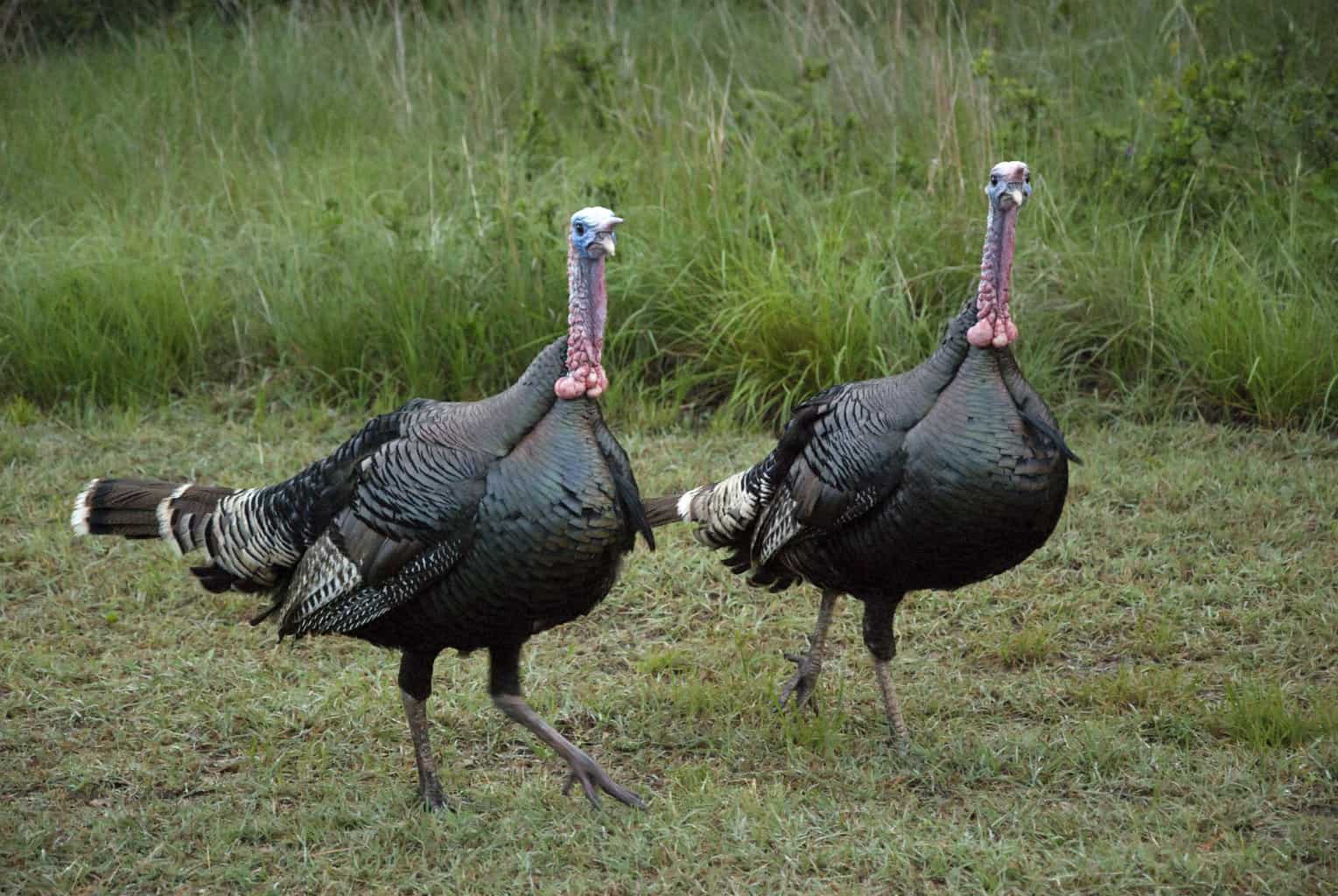
Wild turkeys are big! Large varieties consistently weigh upwards of 25 pounds!
Like chickens, they are game birds. Unlike chickens, they usually carry much more meat on their bodies.
Wild turkeys are mostly dark brown. They have some greenish-brown iridescent coloring throughout their feathers. Their wings are even darker, with white bars across them.
Their face skin can range from blue to grey, and their wattles are usually pink or red. Females and males have smaller wattles than males, whose wattles can dangle off their chin.
They spend their lives in small flocks that live together. When breeding season arrives, the males show off their feathers in an attention-grabbing mating display.
They are a North American bird and live throughout much of the United States and parts of Canada and Mexico. They are non-migratory.

